Alexander Pope (1688-1744) was a poet, satirist and translator. He is considered to be one of the greatest poets of his age and, after Shakespeare, is the most quoted poet in English history. I've included some of his well-known sayings in this blog. Largely self-taught, he was hampered by ill health. At the age of twelve he began suffering from Pott's disease (tuberculosis of the spine) along with the crippling headaches that would dog him until his death. He grew to a height of only 1.37m (4 ft 6 in).
During his career as a satirist, his sharp and caustic wit caused him to make many enemies amongst critics and politicians- so much so that he kept pistols on his person whilst walking his dog! Once patronised by Queen Caroline- consort of George II- she did not escape his poison pen, so he then became a favourite of her eldest son, and heir to the British throne, Prince Frederick, as relations between mother and son were egregious.
Pope never married but allegedly his lifelong friend, Martha Blount, was his lover.
During his career as a satirist, his sharp and caustic wit caused him to make many enemies amongst critics and politicians- so much so that he kept pistols on his person whilst walking his dog! Once patronised by Queen Caroline- consort of George II- she did not escape his poison pen, so he then became a favourite of her eldest son, and heir to the British throne, Prince Frederick, as relations between mother and son were egregious.
Pope never married but allegedly his lifelong friend, Martha Blount, was his lover.
Pope was also considered to be a fantastic businessman and the money he made form his translation of Homer (Greek author of Iliad and Odyssey; two ancient works of great literature) allowed him to build a Palladian-style villa in Twickenham, on the banks of the River Thames. He moved in in 1719. A pioneer in landscape gardening, he also created a classical cave, or grotto in the brick basement of his house. This he decorated with materials such as iron ore, shells, flint and glass, and minerals such as stalactites, crystals and quartz. He obtained permission to construct a tunnel underneath the road, which gave him direct access to his private garden on the other side of the road.
Today the house is no longer there, having been demolished in 1808, but the grotto still exists and is currently being restored. Radnor House School now sits on the site, so access to the grotto is limited. Its conservation is a work in progress, so some parts were much cleaner and clearer to depict than others.
It was a very warm Saturday when I made my way across London on the train. I was sharing with those decked out to visit Royal Ascot, and I commented that I'd never seen to much badly applied fake tan in all my life (why people bother is beyond me- I prefer to be pale and interesting!)
The grotto consists of 4 chambers- the Lateral Chamber, the Central Chamber, the North Chamber and The South Chamber. Only the latter has been fully restored.
You enter via this iron gate...
On the side of the arch you can make out a lion's face with a cast of feathers above. On the other side of the arch there are faces, but I had to be selective with regard to which photographs I used.
As you move into this Lateral Chamber a circle of stones sits to your left...
On the ceiling is a crown of thorns with a shield depicting the five wounds of Christ (feet, hands and heart) high on the wall behind it.
View down into the Central Chamber. We were given torches to that we could take a closer look at the details.
View back from this point, through the arch to the Lateral Chamber and out of the grotto...
The grotto is lit, in places, by these little electric candles. Low down on the left hand wall is a chunk of hexagonal basalt from the Giant's Causeway in Northern Ireland. This is one of two sent to Pope in 1742 by Sir Hans Sloane.
Closer view...
Stripy faience ceramic and nails...
Close-up...
The cave is full of interesting geology...
'To err is human, to forgive, divine.'
Looking down from the Central Chamber into the tunnel...
Pope added three mirrors which once reflected sunlight off the river and which would shimmer onto the minerals and stones. These are awaiting restoration and are very dirty.
This amber chunk looks almost like a sweet!
Geology of the tunnel...
'First follow nature and your judgement frame.'
Pope erected seats either side of the tunnel...
Did he come to sit here and contemplate? Spring water apparently used to flow from a point just beyond here, underneath a grating.
Pieces of flint, glass slag and quartz...
Looking back down the tunnel...
The end of the tunnel which once led to Pope's landscaped garden. Cross Deep above was probably widened in 1800, so a tunnel extension was built then.
The iron gate at the end of the tunnel. Up above the steps sits St.Catherine's School. (Piece of useless information- former notable pupils include Patsy Kensit and Bonnie Langford.)
Looking back down the tunnel. The extension was pebbledashed in 1923.
More geology...
'Eternal sunshine of the spotless mind'
The flat, pale grey rock to the top left of the photo looks like it has a face- but you have to really peer and use your imagination to see it...
A stripy tile and nails...
Pope used to come down here to contemplate, and gain inspiration by communing with poetic muses...
...If he ever did work down here (and I'm assuming that he did) then it's quite a dark and gloomy place...
The second chunk from the Giant's Causeway is high up on the ceiling...
I then entered the restored South Chamber...
This is a bough from a willow tree...
Iron grate looking back into the visitor entrance...
Decorative (electric!) candles in copper holders light this chamber...
Stone formation and, according to the guide, a mother amethyst to one side...
Brickwork floor. This was very uneven, and carpeted for protection (ours and the grotto's!)
Decoration...
Stacked stones in the one corner...
...And the other...
The statue is of unknown origin and was possibly placed here in the late 19th century.
A closer look...
Perhaps the oddest thing in the whole grotto is this ceramic face, hidden behind the head of the statue. You can only make out the side of the face as the front has been covered over with flint.
Apparently there is an ammonite (fossilised but extinct sea creature) cast above this doorway. I don't know about you, but the only ammonite cast I can make out is down by the floor...
Venturing into the North Chamber and this is yet to be conserved...
...A fact made evident by the collection of stones piled up in crates...
Amber geology resembling sweets on the wall...
Rusty nail. This is loose, suggesting that it probably just fell here, and is not a part of the original design!
The light in the ceiling is adding a bit of glare to the statue of St James of Compostela...
His hat displays his emblem, a scallop shell...
Stone circle...
Wall shield. Sketches from this time show that a Bagnio (cold bath) was in place. Was it ever in use, we wonder?
Geology...
'Hope springs eternal in the human breast.'
Another stone circle...
Iron grill looking out to the visitor entrance...
These look like the ammonite casts mentioned in the guide pamphlet...
Geology...
'The difference is too nice- Where ends the virtue or begins the vice.'
A lump of wood just nailed to the ceiling. This place is full of interesting things, but you have to explore to find some of them.
Who wrote this, I wonder? It looks pretty modern to me...
Indentation of a bird on stone...
Geology...
'Consult the genius of the place.'
A believe this is a Bristol diamond (also known as a geode).
More stripy ceramic- these feature a lot, certainly in the central chamber.
Fossilised lumps.
These rusty scissors are hanging in the North Chamber. We don't know if they date from Alexander Pope's time.
Stepping outwards and upwards into the glorious sunshine overlooking the Thames...
Not a bad view at all!
I have to say, my visit to Pope's Grotto was extremely interesting and I enjoyed learning more about this fine English eccentric.
I'll take my leave of you with my favourite Pope quote...
'Fools rush in where angels fear to tread.'
TTFN
The Miss Elaineous
xxxxxxxxxxxxxxxxxxxxx
xxxxxxxxxx
xxx
x



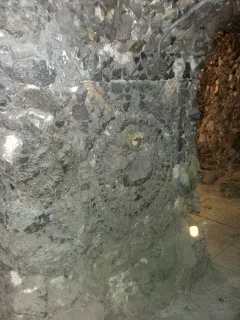







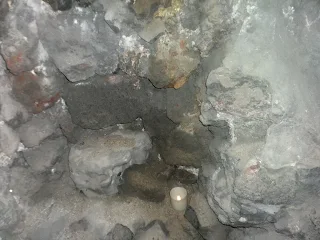
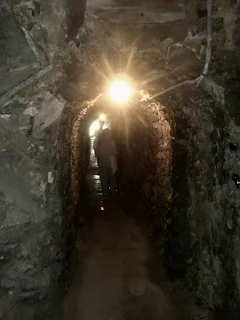












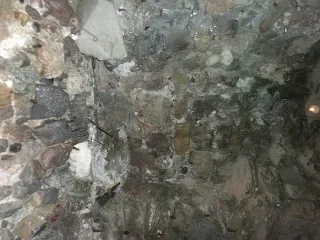

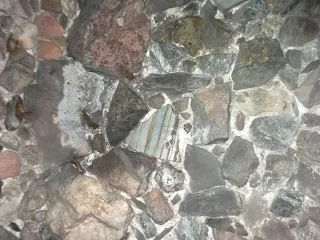









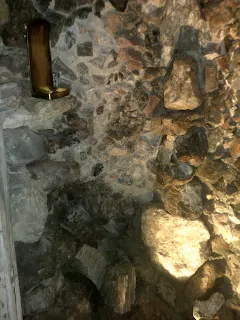



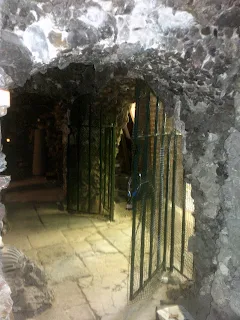




















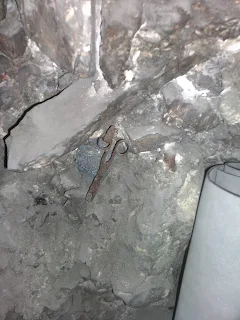


No comments:
Post a Comment